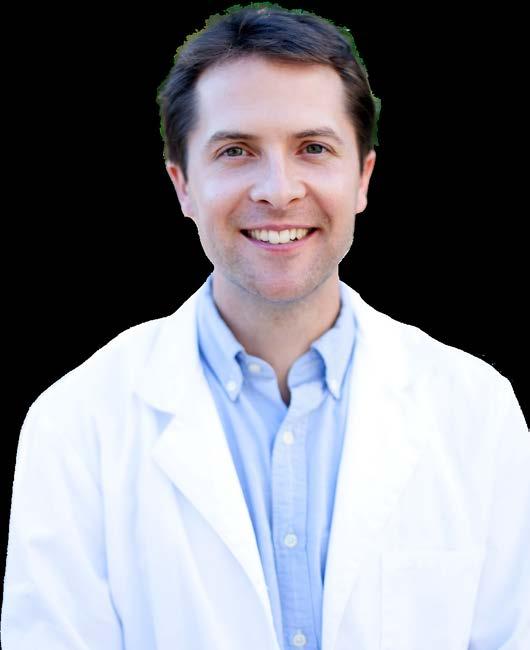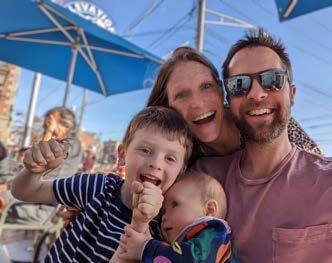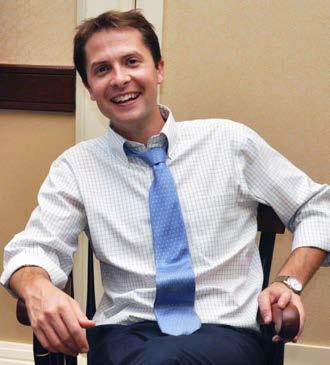
8 minute read
Rethinking Rx
Addressing addiction prevention and recovery with Jacob “Gus” Crothers ’03
GLOBAL WARMING. The war in Ukraine. Gun violence. The lingering effects of the pandemic. With multiple crises dominating the news cycle, America’s opioid epidemic has faded from public consciousness. The threat has not abated, however. Though national overdose deaths have begun a slow decline from a recent peak, rates are still more than 50 percent higher than they were five years ago. More than 932,000 Americans died from drug overdoses between 1999 and 2020, with 44 people dying daily from overdoses involving prescription opioids alone. For the 12-month period ending in July 2022, emergency medical services responded to almost 400,000 calls across the country that required the administration of naloxone, which reverses the effects of opioid overdoses.
Advertisement
Sadly, records continue to accumulate in Maine. In 2022, 716 individuals died from fatal overdoses, surpassing the 2021 record of 631 deaths. The state has one of the highest overdose rates in the country.
Jacob “Gus” Crothers ’03 has been engaged in the fight against opioid use disorder for more than a decade. The son of two physicians, Gus developed a fondness for science and mathematics over the course of his 15 years at Waynflete. He was an eager participant in Science Olympiad, headed up then, as now, by Carol Titterton (see page 19 for Carol’s retirement announcement), and he also fondly recalls math classes with David Neilan and Tom Campbell. “Regardless of what they were teaching, I really enjoyed being in their presence,” Gus recalls. He enjoyed theater during his years in Lower and Middle School, then transitioned to sports, playing soccer, lacrosse, basketball, bowling, and team handball. Gus remembers advisor Pam Paul as someone who regularly served as a sounding board.
When the time came to consider college, Gus was attracted to institutions that incorporated aspects of Waynflete’s ethos. With its open curriculum (there were no required courses or curriculum if you crafted your own major), Brown University stood out. “Both my parents were physicians, so I had a strong sense that I was going to go in that direction,” Gus says. “But I left the doors open. I wanted a school where I could continue to explore and not be locked into a rigid path. Waynflete really set the stage for that.” He earned an undergraduate degree in neuroscience—complemented by “some interesting humanities courses around the edges”—then attended Tufts University School of Medicine. Gus stayed on in Boston for his family medicine residency at Cambridge Health Alliance, working toward his goal of becoming a primary care physician.
Other than a brief review during a psychiatric rotation, Gus and his fellow students had almost no training in addiction medicine or substance use disorder in medical school. “I don’t remember it making an impression on me one way or another,” he recalls. Unbeknownst to him, Gus was starting his residency at the height of the opioid overprescribing epidemic (the worst days for overdoses and deaths were still to come). “I looked around and thought to myself, ‘What’s going on here?’” he recalls. “It felt to me like a lot of doctors were doing more harm than good.” Whether it was opioids, stimulants, alcohol, or tobacco, substance abuse disorders appeared to be the fundamental problem for many of his patients. It seemed to Gus that the emphasis was on treating symptoms, not root causes. He was becoming disillusioned and wondered whether he had chosen the right profession.
A serendipitous connection with a residency mentor who was successfully treating addiction in his primary care practice would change the trajectory of Gus’s career. “I was at the right place at the right time,” he recalls. He discovered that he was passionate about the treatment of substance abuse. When the time came for a leadership project (a requirement of his residency training), Gus co-founded an opioid use disorder clinic with a second faculty mentor. The two retrofitted the work of the private practice addiction treatment program to fit their residency clinic model. Today, that same program continues to train future physicians in addiction medicine and is the source of an extensive body of research.
Gus was still planning for a career as a family physician, albeit with a focus on addiction. But good fortune was to play a role again. A newly minted med school graduate, Gus had moved to Connecticut in 2011 to join his fiancée, Eliza, who was finishing her medical training at Yale. In need of temporary employment, he took on two roles: serving as the part-time physician for a progressive harm reduction-oriented methadone clinic in New Haven and working as the part-time medical director for Grand Rounds, a startup digital health company. “One position gave me further exposure to addiction medicine, while the other provided leadership opportunities. I thought, ‘Let’s see where these go!’”
Grand Rounds’s clients were self-insured Fortune 500 companies focused on improving employee health and wellness while managing healthcare costs. Grand Rounds’s technology brought high-quality medical expertise to its customers’ employees, no matter where they lived. “You could be stocking the shelves in a rural Kentucky Walmart and have access to a world-class cancer specialist,” Gus says. “I helped build that product and provided medical oversight.”
Grand Rounds was also a pioneer in the field of healthcare navigation, using new data science techniques to steer clients’ employees away from physicians whose patients had poorer outcomes. Some of these doctors were identified as “dangerous prescribers”—a reference to overprescribers of pharmaceutical opioids. More often than not, these providers had started out with good intentions (the TV series Dopesick provides a compelling example of this type of physician). They typically worked in solo practices, which meant they weren’t exposed to the normalizing forces of colleagues.
“You ended up with a combination of pharmaceutical reps telling these doctors that they were doing the right thing and patients telling them that they were doing the right thing, and a bankroll that kept getting bigger and bigger,” says Gus. “Put it all together and it became easy to turn a blind eye, ignore the signs of addiction, and tell yourself that you were providing a service that these patients needed. You convince yourself that patients who develop addictions are rare cases. Of course, the patients who overdose don’t come back.”
Gus’s experiences at Grand Rounds taught him how the effective deployment of technology could make a tangible difference in healthcare outcomes. “I saw the overwhelming need and demand for people to be leaders in addiction medicine,” he says. “One reason why healthcare in America is so dysfunctional is that providers really haven’t been managed. This industry has often been defined by the spirit of the rugged individual practitioner. If we’re going to bring healthcare costs down and improve outcomes, we need to apply lessons from other industries. That has to start with leadership and effective management.”
Today, Gus serves as chief outcomes and medical officer at Groups Recover Together, an addiction treatment organization. With hundreds of physical locations across the country, the company also develops and deploys telehealth technology for the remote treatment of addiction. Any barriers that make it difficult for an individual to access high-quality addiction medicine increase the likelihood of an overdose or other negative outcome. Imagine, for example, an individual with opioid use disorder who is obliged to drive 50 miles to a clinic for weekly treatment. Without a reliable means of transportation, they will probably fall out of treatment. Telehealth helps remove these obstacles, particularly during the long period of isolation brought on by the COVID-19 pandemic. (Testifying recently before the Legislature, Maine Director of Opioid Response Gordon Smith said that “it has been been a difficult experience to be managing a very serious [drug] epidemic in the middle of a global pandemic when in fact many of the things you might do to respond to the global pandemic adversely affected the [drug] epidemic.”)
Remote treatment is not a magic bullet—like any powerful tool, it can be misapplied. And for some individuals, the relationships that grow from face-to-face interactions are what help sustain recovery. The ultimate solution is found in a complementary mix of in-person and telehealth services. “Finding that optimal balance is the focus of my work right now,” Gus says.
A continuing crisis
A mentor once told Gus, “If you want to understand addiction as a problem, you have to first understand addiction as a solution.” Individuals who suffer from substance abuse disorder are rational actors who use drugs to temporarily escape from despair or overwhelming situations. While medications can help, Gus contends that the root causes of addiction go beyond mere biochemical foundations to the fabric of our social structure. “This is why I find addiction medicine so fascinating,” he says. “You have to go beyond the medical science to look at all the forces that drive substance abuse, like income inequality, the strength of the social safety net, and the healing nature of our relationships. It’s when these things begin to fray that addiction rears its head.”
Today, treatment is more accessible than ever before. Many medical providers now embrace addiction medicine as part of their practice, and some of the regulations that limit who can prescribe medicines (and where they can be prescribed) have been relaxed. Overprescribing has declined significantly—healthcare providers are no longer the primary drivers of the problem. Finally, addiction medicine no longer gets short shrift in medical school. “We’re finally getting to the point where addiction isn’t just a specialty silo anymore. If you’re a medical student or a resident today, you’re going to get much more exposure to it than someone from my generation did,” Gus says.
But many of the underlying forces that drive people into substance abuse remain unaddressed. “We can’t just pat ourselves on the back,” says Gus. “The stakes—particularly the risk of overdose—are so much higher today because of the potency and dominance of fentanyl in the street drug supply.” (Alone or combined with other drugs, fentanyl accounted for almost 80 percent of overdose deaths in the state last year.)
In October 2020, Oxycontin manufacturer Purdue Pharma pled guilty to felony charges in federal court. The settlement agreement imposed a criminal fine and civil penalty of more than $8 billion, the largest penalty ever levied against a pharmaceutical company. Moreover, it required that the company be dissolved and its assets repurposed entirely for use by state and local governments to fund opioid abatement programs and overdose rescue medicines (Maine received $28 million). “My hope is that these funds are used for thoughtful prevention and treatment efforts and that they aren’t over-allocated into law enforcement,” says Gus. “Fentanyl is so much easier to smuggle. It’s an example of what can happen when you put too much emphasis on law enforcement.”
Returning to Maine
Gus hasn’t strayed far from his roots. Today, he lives near his childhood home in Portland with Eliza, who directs undergraduate medical education at Maine Medical Center, and their children, Annika and Augie. He is a dedicated year-round cyclist and an enthusiastic supporter of Portland Community Squash’s educational and community-building programming.
“I am lucky—it’s very easy for me to see tangible examples of how thousands of individual’s lives are improved by the practice I work for,” he says. “But I’m also motivated to help this organization become more effective, to deliver even higher-quality care, and have an even greater impact. We’re currently focused on opioids, but there is no shortage of demand across the full spectrum of substance use disorder. There’s so much dysfunction in healthcare, yet still so much low-hanging fruit.”

Reflecting on his early career, Gus says he believes that the smartest—and scariest—thing he did was take a risk when graduating residency and starting two nontraditional jobs. He encourages today’s Waynflete graduates to stay open and look for unexpected opportunities. “Even if they’re not the precise fit or the exact narrative you had in mind, that open-mindedness is what will help you find what you’re passionate about,” he says. “Waynflete was a huge part of that—it taught me that everyone’s ideas are worth listening to. It made me feel like I actually had the skills and the abilities to be a leader.”
Listen to a recent Maine Public Radio update on access to drug treatment programs in the state: bit.ly/wf-treatment.











